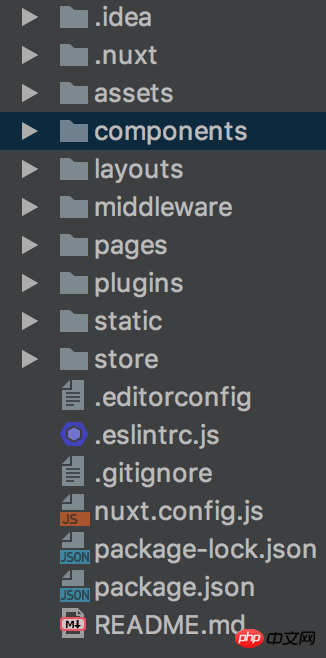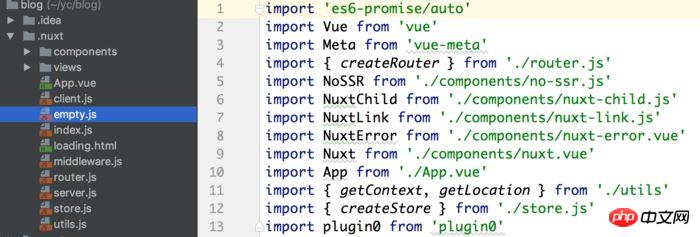Nuxt.js framework (detailed tutorial)
This article mainly introduces the Vue.js universal application framework-Nuxt.js getting started tutorial. Now I share it with you and give it as a reference.
For single-page applications built with React and Vue, SEO is a well-known problem. Server-side rendering (SSR-server Side Render) seems to be the best solution at present. React applications have Next.js, and the solution for Vue is Nuxt.js.

1. Introduction
Official website: https://nuxtjs.org/
GitHub: https: //github.com/nuxt/nuxt.js
What is Nuxt.js?
Nuxt.js is a universal application framework based on Vue.js.
By abstractly organizing the client/server infrastructure, Nuxt.js mainly focuses on the UI rendering of the application.
Our goal is to create a flexible application framework that you can use to initialize the infrastructure code of new projects, or use Nuxt.js in existing Node.js projects.
Nuxt.js presets various configurations required to develop server-rendered applications using Vue.js.
In addition, we also provide a command called: nuxt generate, which provides the function of generating corresponding static sites for Vue.js-based applications.
We believe that the functionality provided by this command is a new step towards developing web applications that integrate various microservices.
As a framework, Nuxt.js provides many useful features for the typical application architecture pattern of client/server, such as asynchronous data loading, middleware support, layout support, etc.
2. Build the first Nuxt.js project
It is recommended to use the template provided by Nuxt. It is assumed that you have installed vue-cli. If not, please execute npm install vue-cli -g to install vue-cli first.
$ vue init nuxt-community/starter-template <project-name>
Go to the project folder to install dependent packages.
cd <project-name> npm install
Start the project.
npm run dev
Open the browser and visit http://localhost:3000. You can see the page rendered by Next.
3. Add page
The newly completed project structure is as shown below:

Project structure
Nuxt agrees that all pages are placed in the pages folder, and Nuxt will automatically generate the corresponding route based on the directory structure.
Now create a new Vue file test.vue under pages, and visit http://localhost:3000/test to see the page you just added.
4. Introduce third-party plug-ins
Normally we need to introduce third-party plug-ins, such as front-end components, logs, etc.
The first step is of course to install the plug-in. Here we take element-UI as an example.
npm install element-ui
Although I downloaded the element-ui package, it cannot be directly imported and used in the Vue instance like a normal project. Nuxt's kernel projects are all in the .nuxt directory. Modifying the files below will not take effect. Because the file will be regenerated every time you compile, directly modifying the project file is invalid.

Kernel project structure
Although it cannot be modified directly, Nuxt provides a special way to introduce third-party plug-ins.
The first step is to create a new js file element-ui.js in the pulgin folder. The contents of the file are as follows.
import Vue from 'vue' import Element from 'element-ui' import 'element-ui/lib/theme-chalk/index.css' Vue.use(Element)
The second step is to modify nuxt.config.js. Add plugins attribute.
/** * include third-party plugin */ plugins: ['~plugins/element-ui'] // element-ui.js文件地址
After recompiling, Nuxt will compile the third-party plug-in and use it. At this time, the third-party plug-in can be used in any Vue file.
5. Static resource files
You can put the static resource files in the static folder, and then use http://localhost:3000/< Filename> to access static resource files.
Nuxt provides many more functions, such as dynamic routing and ESLint code detection. That’s it for today. For more in-depth information, please refer to the official website.
The above is what I compiled for everyone. I hope it will be helpful to everyone in the future.
Related articles:
Use Vue to imitate Toutiao (detailed tutorial)
How to configure eslint for React development
JS scope and pre-parsing mechanism (detailed tutorial)
How to use enumeration types to implement HTML drop-down boxes in Vue
How to package static resources in vue
The above is the detailed content of Nuxt.js framework (detailed tutorial). For more information, please follow other related articles on the PHP Chinese website!

Hot AI Tools

Undresser.AI Undress
AI-powered app for creating realistic nude photos

AI Clothes Remover
Online AI tool for removing clothes from photos.

Undress AI Tool
Undress images for free

Clothoff.io
AI clothes remover

AI Hentai Generator
Generate AI Hentai for free.

Hot Article

Hot Tools

Notepad++7.3.1
Easy-to-use and free code editor

SublimeText3 Chinese version
Chinese version, very easy to use

Zend Studio 13.0.1
Powerful PHP integrated development environment

Dreamweaver CS6
Visual web development tools

SublimeText3 Mac version
God-level code editing software (SublimeText3)

Hot Topics
 1378
1378
 52
52
 How do I create and publish my own JavaScript libraries?
Mar 18, 2025 pm 03:12 PM
How do I create and publish my own JavaScript libraries?
Mar 18, 2025 pm 03:12 PM
Article discusses creating, publishing, and maintaining JavaScript libraries, focusing on planning, development, testing, documentation, and promotion strategies.
 How do I optimize JavaScript code for performance in the browser?
Mar 18, 2025 pm 03:14 PM
How do I optimize JavaScript code for performance in the browser?
Mar 18, 2025 pm 03:14 PM
The article discusses strategies for optimizing JavaScript performance in browsers, focusing on reducing execution time and minimizing impact on page load speed.
 What should I do if I encounter garbled code printing for front-end thermal paper receipts?
Apr 04, 2025 pm 02:42 PM
What should I do if I encounter garbled code printing for front-end thermal paper receipts?
Apr 04, 2025 pm 02:42 PM
Frequently Asked Questions and Solutions for Front-end Thermal Paper Ticket Printing In Front-end Development, Ticket Printing is a common requirement. However, many developers are implementing...
 How do I debug JavaScript code effectively using browser developer tools?
Mar 18, 2025 pm 03:16 PM
How do I debug JavaScript code effectively using browser developer tools?
Mar 18, 2025 pm 03:16 PM
The article discusses effective JavaScript debugging using browser developer tools, focusing on setting breakpoints, using the console, and analyzing performance.
 Who gets paid more Python or JavaScript?
Apr 04, 2025 am 12:09 AM
Who gets paid more Python or JavaScript?
Apr 04, 2025 am 12:09 AM
There is no absolute salary for Python and JavaScript developers, depending on skills and industry needs. 1. Python may be paid more in data science and machine learning. 2. JavaScript has great demand in front-end and full-stack development, and its salary is also considerable. 3. Influencing factors include experience, geographical location, company size and specific skills.
 How do I use source maps to debug minified JavaScript code?
Mar 18, 2025 pm 03:17 PM
How do I use source maps to debug minified JavaScript code?
Mar 18, 2025 pm 03:17 PM
The article explains how to use source maps to debug minified JavaScript by mapping it back to the original code. It discusses enabling source maps, setting breakpoints, and using tools like Chrome DevTools and Webpack.
 Getting Started With Chart.js: Pie, Doughnut, and Bubble Charts
Mar 15, 2025 am 09:19 AM
Getting Started With Chart.js: Pie, Doughnut, and Bubble Charts
Mar 15, 2025 am 09:19 AM
This tutorial will explain how to create pie, ring, and bubble charts using Chart.js. Previously, we have learned four chart types of Chart.js: line chart and bar chart (tutorial 2), as well as radar chart and polar region chart (tutorial 3). Create pie and ring charts Pie charts and ring charts are ideal for showing the proportions of a whole that is divided into different parts. For example, a pie chart can be used to show the percentage of male lions, female lions and young lions in a safari, or the percentage of votes that different candidates receive in the election. Pie charts are only suitable for comparing single parameters or datasets. It should be noted that the pie chart cannot draw entities with zero value because the angle of the fan in the pie chart depends on the numerical size of the data point. This means any entity with zero proportion
 The difference in console.log output result: Why are the two calls different?
Apr 04, 2025 pm 05:12 PM
The difference in console.log output result: Why are the two calls different?
Apr 04, 2025 pm 05:12 PM
In-depth discussion of the root causes of the difference in console.log output. This article will analyze the differences in the output results of console.log function in a piece of code and explain the reasons behind it. �...




